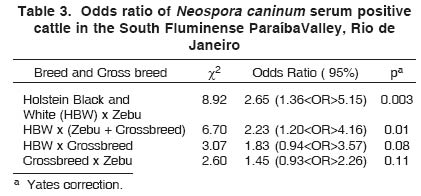The infection by Neospora caninum of different cattle breeds in dairy properties in two municipalities of the South Fluminense Paraíba Valley, state of Rio de Janeiro, was evaluated. Considering a sampling universe of 2,491 cows, blood samples were collected from 563 dairy cows in 57 farms, which were randomically selected in proportion to the number of animals, using a random stratified sampling system. For each property the number of selected cows was proportional to the herd size. Abortion or other reproductive disorders were not considered as criteria for selecting the animals, and seropositivity was determined by indirect enzyme-linked immunosorbent assay (ELISA). A high association (p=0.006) between seropositivity and racial patterns was found. The analysis revealed that in comparison of pure black-and-white Holstein cows versus Zebu (p=0.0028), Holstein cows showed 2.65 times greater odds for seropositivity. In the same way, by comparing black-and-white Holstein versus Zebu + crossbreed Zebu/Holstein (p=0.01), it was noted that there is 2.23 times more chance for seropositivity in Holstein cattle. There were no significant differences concerning the comparison of Holstein cattle versus crossbreed Zebu/Holstein (p=0.08) or Zebu versus crossbreed Zebu/Holstein (p=0.11). This study supports the hypothesis that there is a close association between cattle breeds and the frequency of infection by N. caninum.
Neospora caninum; association; cattle breed



